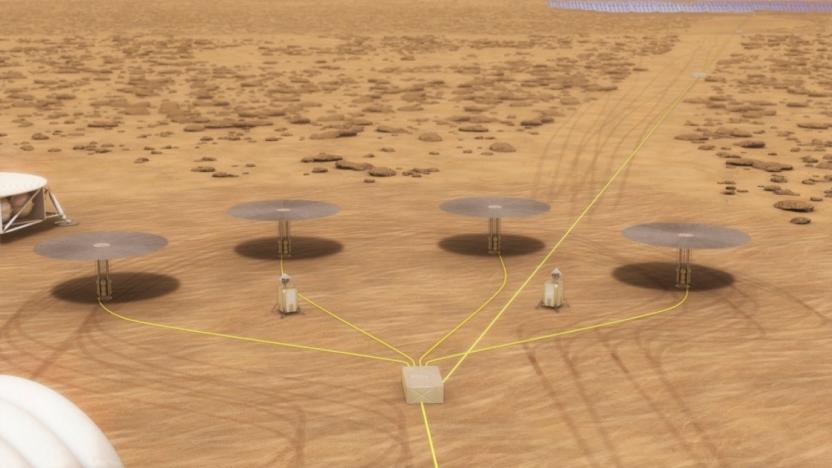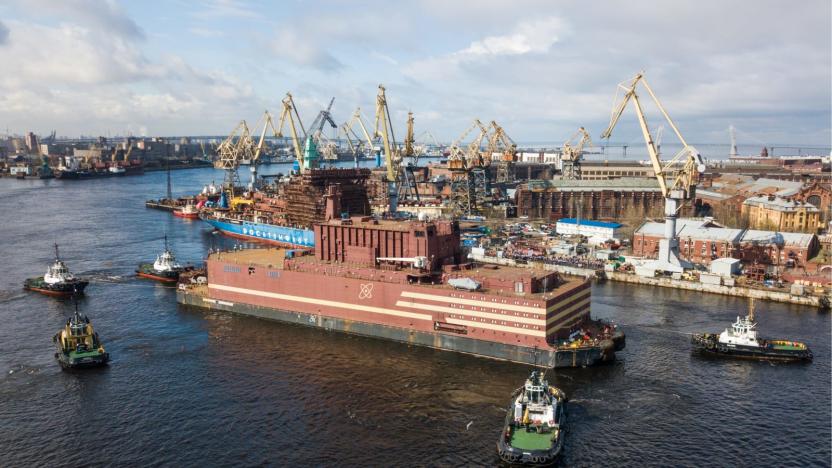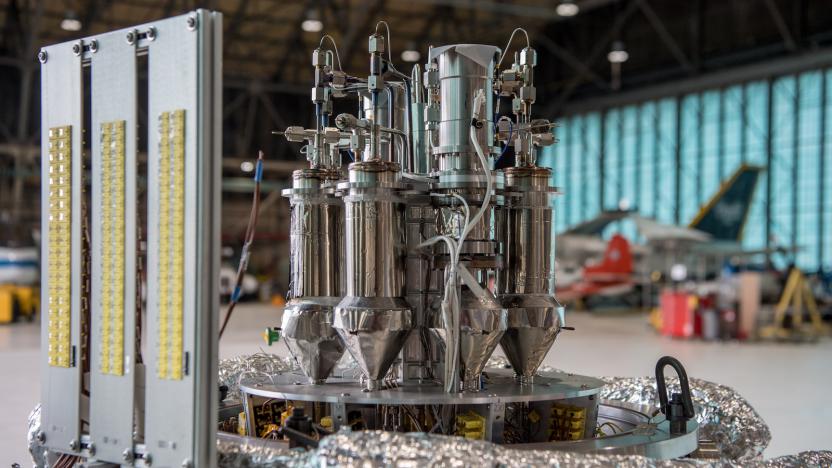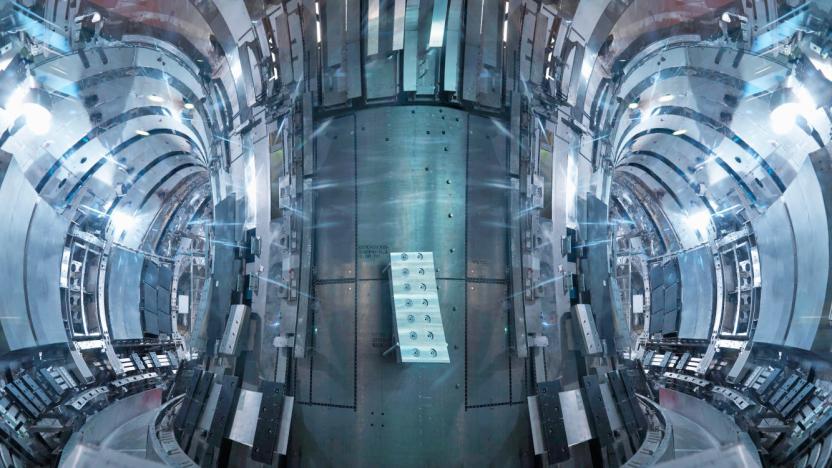NuclearReactor
Latest

NASA completes full-power tests of small, portable nuclear reactor
Being able to generate power will be essential for long-term space travel. Powering a stay on Mars, for example, will require a lot of fuel, way more than we can pack onto a rocket. That's why NASA, Los Alamos National Laboratory, the Department of Energy and a number of other groups have been working on a small, transportable nuclear reactor that can reliably generate power on the go. The reactor they're developing is called Kilopower and earlier this year, they announced that they had conducted successful tests of the system. In March, the team ran the first full-power tests and during a press conference today, they reported that those tests went extremely well.

Russia launches floating nuclear power plant on Baltic Sea (updated)
Multiple nations, including China and the US, have pursued offshore or floating nuclear reactors, and now Russia will give it a go. Russia has launched a floating nuclear power plant or its own, the 70-megawatt Academik Lomonosov, on the Baltic Sea. Starting from St. Petersburg, it will be towed around Norway to a Russian town called Murmansk to take on nuclear fuel. From there, it will head to the Arctic to power the oil-industry town of Pevek, along with a desalination plant and drilling rigs.

NASA tests small nuclear reactor that could power a habitat on Mars
Everyone from Elon Musk to Donald Trump wants to send a crewed mission to Mars in the not too distant future, but there are quite a few problems that need to be solved before we can achieve that goal. A major one is the issue of energy. Long-term stays on Mars, or anywhere else for that matter, will require lots of energy, as will the trip back to Earth. However, loading a rocket up with all of the necessary fuel won't work -- we would need too much. So a way to create fuel on the go is a must and researchers at NASA, Los Alamos National Laboratory and the Department of Energy announced today that they've conducted successful tests of a system that can do just that.

Researchers create a new fusion recipe that boosts energy output
Nuclear fusion is an attractive way to create energy. It generates hardly any waste, doesn't pollute the planet and takes advantage of elements that we have plenty of. But fusion takes a lot of work and the energy payout isn't yet at the level that makes it suitable for producing power. But researchers at MIT have developed a new fusion recipe that boosts energy production by ten-fold.

‘Safer’ thorium reactor trials could salvage nuclear power
A Dutch nuclear research institute is conducting the first experiment in close to five decades on molten-salt nuclear reactors based on thorium. Long hailed as a potential "safer" nuclear power, thorium reactor research could provide clean, affordable and "large-scale energy production." That's according to scientists from the Nuclear Research and Consulting Group (NRG) in Petten, Netherlands. If successful, the trials could result in a switch to next-gen thorium reactors, which are less likely to suffer meltdowns in comparison to their current uranium-based counterparts.

Fukushima nuclear reactor will get mapped with subatomic particles
Scientists from Los Alamos National Lab have discovered how to look through and map just about anything with a new process: the science-fictionally sounding muon tomography. Even in places like the highly radioactive Fukushima reactor, the method doesn't require any disassembly or any need for x-rays or ultrasound. Instead it logs the movement of muons (of course), a radioactive subatomic particle that exists, well, everywhere. Two giant aluminum sides are put either side of whatever needs looking into, and the system measures the trajectory of these muon particles. From this, the scientists are able sketch the object, given enough of the tiny things.

UnEasyshare: Kodak's now-defunct, Rochester-based nuclear reactor
Ready for this unsettling Kodak moment? It seems the one-time imaging powerhouse held a decades-long secret deep in a bunker below Building 82 on its Rochester campus. The now vacant facility, a concrete-shielded chamber built in 1974, was once home to a californium neutron flux multiplier (CFX) or, in layman's terms, a small nuclear reactor as recently as six years ago. Certainly, that's not the technology one would normally associate with an outfit built on the foundations of photography, but according to recently released documents, its three and a half pound store of enriched uranium was used primarily for neutron radiography -- an imaging technique -- and chemical purity testing. The site's long been shut down and the radioactive material in question carted off with federal oversight, but for denizens of that upstate New York territory, alarming news of the reactor's existence has only just surfaced. Before you cast Kodak the evil side eye, bear in mind post-9/11 policies forbade the company from making the whereabouts of its small reactor widely known, though earlier scientific studies did make reference to the CFX's existence. It's an eye-opening glimpse into the esoteric machinations of private industry and the deadly dangers that lurk below your feet.

Fukushima technician gives behind-the-scenes look at the cleanup operation
New details about the robotics deployed to help clean up Japan's Fukushima nuclear plant have emerged, thanks to a series of blog posts penned by an anonymous technician. Known only as 'S.H.', the blogger wrote of the effectiveness of the donated iRobot Packbots and Warriors (despite their prolonged exposure to electronics-damaging radiation), while criticizing the Tokyo Electric Power Company for what he saw as inept supervision, unreasonable schedules and disregard for technician safety. S.H., who helped retrofit a vacuum cleaner onto a robot to collect radioactive dust, also revealed technical details about the robots, explaining that they were manipulated with a PlayStation-style controller via a Panasonic Toughbook and that the devices were most effective in pairs, which allowed for better wireless connectivity and faster emergency response. The site was taken down after it began circulating on Twitter but IEEE kept and translated the posts, available for your perusal at the source link, below.

iRobot Packbots enter Fukushima nuclear plant to gather data, take photos, save lives (video)
iRobot recently deployed a pair of robots to the Fukushima Daiichi nuclear plant in Japan, where intense levels of radiation have made it increasingly dangerous for human rescue workers to operate. The remote-controlled Packbots entered one of Fukushima's reactor buildings on Sunday morning, in the hopes of providing authorities with a better idea of what's going on inside the plant's nether regions. Each Packbot entered the facility with an attached video camera, allowing Tokyo Electric Power (TEPCO) to receive live interior images and temperature readings of the troubled reactor building. It would certainly be a daunting task for any human to undertake, but the Packbot is specially designed to cope with hazardous conditions (in the past, it's been used to defuse bombs for the U.S. Army). And the Packbot isn't alone, either. Authorities are also using a mechanical excavator and transporter to wipe away some of the debris outside the plant, while an unmanned helicopter has been hoisted skyward, to take aerial photos of the area. TEPCO has yet to release information on the Packbots' findings, but if Sunday's mission proves to be a success, they'll be sent in to two other reactor buildings, to do it all over again. Check out a video and an extra image of the Packbot, after the break.

Obama's 2012 budget includes push for 'mini-nuke' reactor development
The President revealed his 2012 budget proposal today, including $853 million for nuclear energy research -- which includes development of "mini-nukes," or small, modular reactors that can be shipped and deployed relatively quickly, and built relatively cheaply (up to $2 billion, as opposed to the $10 billion price tag of your traditional reactor). But don't get excited -- you won't likely be able to get your own backyard reactor just yet. For the time being, they're to be placed in existing large-scale labs like the Oak Ridge National Laboratory in Tennessee. It is hoped that the reactors will bring a 28 percent reduction of the Energy Department's carbon footprint by 2020.

Toshiba and Bill Gates-backed TerraPower discussing small-scale nuclear reactors
It would seem that Toshiba hasn't given up on its dream of producing a nuclear reactor for the home, and its latest potential partner counts quite the big name among its backers. Run by a former Microsoft exec and partially funded by Bill Gates himself, TerraPower is said to have opened preliminary discussions with Toshiba regarding a possible joint venture between the two companies. The aim is, predictably, to make safer, smaller, more socially acceptable, and just plain better reactors. TerraPower boasts its tech can run without refueling for up to 60 years on depleted uranium and Bill Gates has gotten enthusiastic enough about the whole thing to give a 30-minute talk on the matter. Click past the break for the video.






